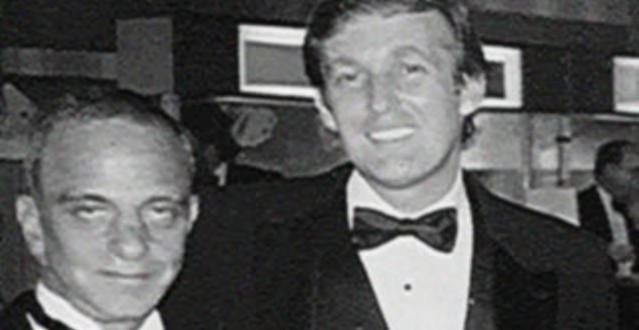For the next two decades, Trump was represented by Roy Cohn, a closeted gay, right-wing lawyer who taught him all the tricks that would later help him lie, intimidate and bully his way into the US Presidency. Feature by Andrew M Potts.

A rare image of Cohn and Trump together, possibly at the opening of Trump Tower.
NEWS FEATURE
In 1973 a 27-year-old Donald Trump, fresh in the public eye, needed a lawyer and fast.
Managing his father’s property empire of more than 14,000 apartments across the New York boroughs of Brooklyn, Queens and Staten Island had landed him in hot water with the US Justice Department over allegations that his company had violated the Fair Housing Act by discriminating against African-American renters.
After receiving complaints, the Justice Department had sent white and black “testers” to apply to rent apartments in more than a dozen buildings owned by the Trump Management Corporation and found that black applicants were either falsely told that apartments were no longer available when they applied to rent them or were offered different rental terms and conditions to whites.
“The government contended that Trump Management had refused to rent or negotiate rentals ‘because of race and colour,’ ” the New York Times reported in October of that year.
“The company… had misrepresented to blacks that apartments were not available.”
Trump’s response to the charges? “They are absolutely ridiculous,” he told the Times. “We never have discriminated, and we never would.”
Trump had just 20 days to respond to the Justice Department’s charges against the company. He turned to the notorious anti-communist witchhunter turned New York power lawyer, Roy Cohn.
Trump first met Cohn at the exclusive Le Club on New York’s East Side where both were members. Cohn advised Trump to hit back hard against the government with a countersuit demanding $100 million dollars – a ridiculous sum of money in the 1970s: over half-a-billion in today’s dollars.
Cohn also called up the head of the Justice Department’s civil rights division and demanded that the lawyer who had brought the case be fired. The threat was not well received, but they knew Trump and Cohn meant business now.
The judge eventually dismissed the countersuit as a waste of time and the Trump Management Corporation settled the case with the Justice Department two years later – but Trump avoided any admission of personal culpability in the agreement.
Trump claimed the settlement as a victory to the New York Times because it did not require the Trump Management Corporation to “accept persons on welfare as tenants unless as qualified as any other tenant”.
Forty-one years later, after winning the 2016 US election, Trump would claim another settlement as a victory – agreeing to pay $25 million to former Trump University students to avoid having to stand trial while holding the office of the President. Trump spun the settlement as a win on Twitter, claiming that the payout was only “a small fraction of the potential award,” adding that he would have liked to continue fighting the case had he not won the election. In actuality, it’s unlikely that the total pay-out to students would have been more than $15 million had he proceeded and lost the case.
Looking back over four decades, Tony Schwartz, the ghost writer of Trump’s bestseller The Art Of The Deal, sees the 1973 case and his involvement with Cohn as a pivotal moment for Trump that shaped the man we see today.
“This is a classic example of where Trump begins to demonstrate something he talks about all the time today, which is that he’s a counterpuncher,” Schwartz told PBS’ Frontline in July.